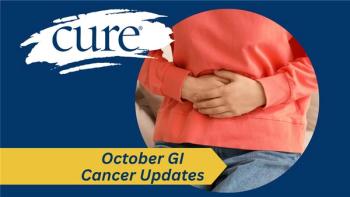
Advancements Reshape Treatment for Non-Small Cell Lung Cancer
Key Takeaways
- Zipalertinib showed a 35% overall response rate in EGFR exon 20 mutated NSCLC, with notable CNS activity and a favorable safety profile.
- NeoADAURA trial highlighted the feasibility of neoadjuvant EGFR TKI use, achieving over 90% surgical resection rates in early-stage EGFR-mutant lung cancer.
Dr. Prantesh Jain and Dr. Joshua Sabari delved into the numerous advances in NSCLC following 2025 ASCO, highlighting the REZILIENT-1 and NeoADAURA trials.
Dr. Prantesh Jain and Dr. Joshua K. Sabari explained that there were numerous advances in the non-small cell lung cancer (NSCLC) treatment space following the
Jain sat down for an interview with our host, Sabari, to highlight what these advancements in care mean for patients with NSCLC, delving into the topline takeaways, including efficacy and safety. To hear more from Sabari and Jain, don’t forget to
Sabari is the editor in chief of CURE. He also serves as an assistant professor in the Department of Medicine at NYU Grossman School of Medicine and director of High Reliability Organization Initiatives at Perlmutter Cancer Center. Jain is a medical oncologist at Roswell Park Comprehensive Cancer Center, in Buffalo, New York, where he also serves as an assistant professor of Oncology in the Department of Medicine. He also works at the State University of New York at Buffalo as a clinical assistant professor.
Sabari: Hello. I'm Dr. Joshua K. Sabari, a thoracic medical oncologist at NYU Langone Health Perlmutter Cancer Center, in New York, and I'm also the editor in chief of CURE. I'm really excited today to be joined by Dr. Jain, a thoracic medical oncologist.
Dr. Jain, please introduce yourself.
Jain: Hi, thanks for having me. I'm Dr. Prantesh Jain, a thoracic oncologist at Roswell Park Cancer Center, and I'm excited to be here to share updates in lung cancer from ASCO this year.
Sabari: Looking at the NSCLC space, which is far more common than small cell lung cancer, and makes up about 85% of all lung cancer diagnosed. Tell me, Dr. Jain, what were you excited about at ASCO 2025?
Jain: One very interesting study we were anticipating for patients with EGFR exon 20 insertion mutation NSCLC
To provide some context, although EGFR exon 20 mutated NSCLC comprises approximately 1% to 2% of cases, these tumors are generally resistant to first- and second-generation TKIs and also do not show a good response to immunotherapy combinations. The REZILIENT-1 trial is a phase 1/2 study of zipalertinib, an oral EGFR TKI with very promising central nervous system (CNS) penetration. It enrolled 244 patients with advanced NSCLC harboring these mutations.
The two key cohorts were: patients post-platinum chemotherapy who had not received any prior exon 20 targeted therapy, and those who had received prior platinum and prior targeted therapy. Zipalertinib was administered at 100 milligrams orally twice daily. Patients with stable and untreated brain metastases were permitted in this study.
The confirmed overall response rate was 35%, with a median duration of response close to nine months. In the subgroup analysis, responses in the platinum-only group were around 40%, with a duration of response of 8.8 months. What was particularly encouraging to note was that the response rate in patients post-Rybrevant (amivantamab-vmjw) was still around 30%, with a duration of response of 14.7 months. For patients who had received other oral TKIs previously, the response rate was much lower, as expected, at approximately 14%, with a duration of response of 4.2 months.
The drug demonstrated activity in patients with brain metastases, achieving a 31% response rate in this group. The safety profile was quite acceptable; the most common grade 3 or higher adverse events included anemia (7%) and a pneumonitis rate of 2.5%. To put this into context, Rybrevant is approved for EGFR exon 20 mutated NSCLC, but compared to Rybrevant, zipalertinib showed lower rates of paronychia, edema, and infusion reactions. This may improve patient adherence and quality of life, especially in older and frail patients.
I believe zipalertinib offers a convenient oral treatment option with durable responses and CNS activity, addressing an unmet need, particularly in patients who progress on prior therapies like Rybrevant. There is an ongoing trial, REZILIENT-3, evaluating this agent in the first-line setting.
Sabari: I couldn't agree more. EGFR exon 20 is an uncommon or rare space, affecting about 1% of patients, but it is very important to have more oral therapeutics available for our patients. I think we have time for maybe one more, Dr. Jain. Let's briefly discuss the NeoADAURA trial. Tell me why that was so practice-changing in the early-stage EGFR-mutant lung cancer space.
Jain: The NeoADAURA trial was particularly interesting, especially as the field increasingly utilizes active drugs in the neoadjuvant setting to make patients more eligible for resection and to achieve a deeper response. However, I feel its primary significance was in demonstrating the feasibility of an EGFR TKI in the early space prior to resection, with over 90% of patients ultimately receiving definitive surgical resection.
The trial basically tested a primary endpoint of major pathologic response. While this has not yet been established as a clear surrogate for long-term survival, and remains to be fully determined, it is a heterogeneous endpoint, comprising both complete pathologic response patients and those with viable tumor (10% or less of the tumor remaining). Nevertheless, what the study does tell us is that this is a feasible option, especially for downstaging patients with N2 disease, which is a truly challenging area for surgical resectability and overall outcomes.
What still needs to be seen is the percentage of nodal clearance after neoadjuvant treatment. This will help determine the exact contribution of this neoadjuvant approach — Tagrisso (Osimertinib) given before surgery — as opposed to just having three years of adjuvant Tagrisso in this space, which is already an approved standard of care.
Sabari: I agree more. I want to thank you, Dr. Jain, for giving us your insights into the ASCO 2025 lung cancer space. I also want to thank the CURE community, as well as our patients and our listeners. Dr. Jain, thank you for joining us.
Sabari: Thank you.
Transcript has been edited for clarity and conciseness.
For more news on cancer updates, research and education,





